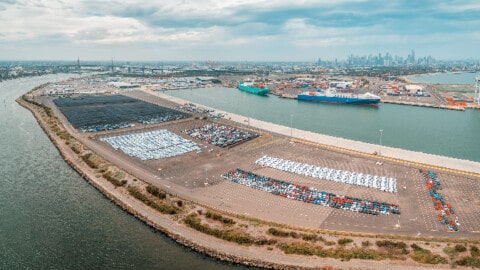With climate conditions changing, our roads need to as well. The Australian Road Research Board — Australia’s national transport research organisation — looks at how we can design our roads to be more resilient in the face of extreme weather, and some of the new sustainable materials and technologies we can use.
Extreme weather and the need for resilient road pavements
The 2018 Bureau of Meteorology’s Annual Climate Statement reported that 2018 was the third-hottest year on record, at 1.14°C above the long-term average. Each of Australia’s ten hottest years on record has occurred since 1998. In addition, large parts of the country experienced drought while others had their highest summer rainfall in decades. There has also been a trend towards wetter and longer wet seasons across much of northern Australia, while southern Australia has seen reduced falls and an increase in extreme fire risk days.
Previous major rainfall events, particularly the 2010–12 events across Queensland associated with La Niña, highlighted the vulnerability of our transport infrastructure network to such events (refer Figure 1, featured image, above). The impact of climate trends may mean that parts of the country are exposed to more frequent and more severe weather events, that may not necessarily be appropriately accounted for in current planning and design practices.
Impact of extreme weather on our road pavements
Both very high temperatures and rainfall could have a detrimental effect on the performance of pavements, if not properly accounted for during the materials selection and design process. The impact of high temperatures is more prevalent to bituminous materials (i.e. asphalt and sprayed seals), whereas the effect of high rainfall is more prevalent on unbound granular pavement materials. Given that the majority of the sealed road network across Australia comprises of unbound granular pavements with either a sprayed seal or asphalt surface, the importance of adequately considering the more frequent extreme weather events being experienced cannot be overstated.
Bitumen used in asphalt and sprayed seals is visco-elastic in nature, and its rheological properties are a function of temperature. The lower the temperature, the stiffer and more brittle the bitumen becomes. Conversely, the higher the temperature the softer the bitumen becomes, increasing the risk of bleeding or flushing in sprayed seals or permanent deformation in asphalt layers (see Figure 2).

Figure 2: Typical bleeding of a sprayed seal (Source: ARRB)
The softening point of bituminous binders is often used to assess the temperature at which the binder reaches a certain degree of softness under specific test conditions. Conventional unmodified bituminous binders have a typical softening point of less than 50°C. It is however not uncommon for road temperatures in Australia to reach in excess of 60°C during very hot conditions, significantly compromising the ability of the bitumen to perform as intended.
Granular materials commonly used in pavements throughout Australia are often moisture sensitive, meaning that the performance of these materials is a function of the moisture condition at the time of loading. Figure 3 shows an example of how the permanent deformation in an unbound granular specimen increases with increasing moisture content.

Figure 3: Moisture sensitivity of granular materials
Moisture related pavement failures (typically in the form of blow-outs or permanent deformation) are common across the road network following severe rainfall events and can be very costly to repair. As an example, the 2010–2013 floods in Queensland cost the government $6.4 billion in repairs to the road network, with over 50 per cent of these costs used for pavements.
It is therefore important for decision-makers to appropriately consider and account for extreme weather conditions during the planning, design and construction phase of the road network. There are a number of ways to better cope with these conditions, including improved climatic and design modelling, the use of more resilient materials, appropriate technical specifications and improved construction techniques.
How to better cope with extreme weather events
Planning and design
Addressing the need for greater resilience in road infrastructure has been a major focus of the National Asset Centre of Excellence (NACOE) research program, an initiative between the Australian Road Research Board (ARRB) and the Queensland Department of Transport and Main Roads (TMR). A study of alternative approaches to the resilience of our road infrastructure found that significant long-term benefits could be realised from investing more heavily in critical routes to minimise the impact of road closures and reconstruction after events.
In one such example, TMR has increased the use of resilient pavement materials such as foamed bitumen — and reaped immediate benefits with only minimal remedial works required on newly constructed pavements after significant inundation caused by ex-Tropical Cyclone Debbie in early 2017.
Rural roads have long been designed with consideration of the likely rainfall totals each year. As an example, pavements constructed in Queensland regions receiving more than 500mm of annual rainfall are typically designed to a more resilient standard. However, a shifting climate means that the lines separating these climate zones have shifted in some years.
Some parts of western Queensland may experience more frequent heavy falls, while also having longer periods of drought. The 2010–13 major rain and flood events in Queensland were spread far and wide, and showed that the state may be more exposed to widespread pavement failures than previously thought. By tracking climate trends, as well as monitoring the annual likelihood of phenomena such as El Nino and La Nina, asset owners will be better placed to allocate maintenance and rehabilitation funding to bolster the resilience of their networks in a more targeted manner.
To date, the design methodology for pavements in Australia has been relatively simplistic — for example asphalt pavements are designed with a single temperature value assigned according to the closest population centre. With reduced cost of real-time monitoring, and the relative ease of analysis of complex data sets, engineers can better characterise materials, climate and traffic at the design stage. This methodology not only allows for a much more tailored approach, but it enables designers to capture
future climate and traffic trends during design.
Similarly, the risk of early failures of sprayed seal surfacings in very cold and/or wet conditions is being addressed through a location-specific risk-based approach. Project engineers will soon be able to access historical climate data and real-time weather forecasts to better understand their project risk of sprayed sealing at any time of year and take appropriate risk mitigation measures when necessary.
Materials selection and design
In urban and semi-urban environments, asphalt materials can deliver good resistance to water and recover well in the event of flooding, if properly design and constructed. Furthermore, appropriate asphalt mix design and materials selection (e.g. the use of polymer modified binders) can also reduce the risks associated with increased pavement temperatures. The successful technology transfer of the enrobés à module élevé (EME2) in Australia is just one example of an asphalt material with increased
structural capacity and high resistance to rutting in warm climates which can deliver resilient roads at lower cost to the community.
Between major cities, sealed granular pavements constitute the majority of the road network. As mentioned previously, these pavements can be vulnerable to extreme climatic conditions such as high rainfall or heat. Furthermore, environment factors are often combined with an increased freight task. In order to better cope with these conditions, ARRB together with a number of key stakeholders is investigating the structural and material enhancement delivered by in-situ stabilisation techniques (see Figure 4).
As an example, foamed bitumen stabilisation has a proven track record to provide resilient pavements during previous flooding events in Queensland.
ARRB/Austroads research currently underway is developing significant improvements to the laboratory-based mechanistic design methods being used for these cost-effective materials. Using the Accelerated Loading Facility (ALF), ARRB is testing full-scale foamed bitumen pavements and recycled materials. A first phase of the testing program has confirmed the good rut resistance in warm conditions and a second phase is currently assessing the resistance to fatigue cracking.
Crumb rubber modified binders are also gaining popularity across Australia as a sustainable and resilient technology that can provide improved performance when used in sprayed seals and asphalt, especially in severe and challenging locations. A number of road authorities are currently investigating opportunities to facilitate the increased use of this high performance binder on their road networks.

Figure 4: In-situ stabilisation (Source: TMR)
Preserving roads in a good condition in remote regions is extremely important to maintaining access between communities during extreme weather events connected. However, sourcing good-quality road materials can be challenging and locally occurring natural materials are often moisture sensitive and perform poorly when exposed to high moisture conditions. In order to better address the risk of using these materials on rural roads, ARRB has developed a material assessment protocol to manage
situations where naturally occurring material can deliver value for money compared with transporting material from distant quarries.
Materials specification
Internationally, there is a strong drive towards performance based specifications for pavement materials and surfacings to better cope with increased traffic volumes and local environmental conditions. Locally, ARRB has also been proactive in developing improved laboratory assessment methods and performance-based specification framework for road making materials including granular, stabilised and bituminous materials.
As an example, the new and innovative approach to asphalt pavement design adopted by the Queensland Department of Transport and Main Roads allows designers to use mix specific asphalt performance criteria to better deal with the higher temperatures experienced in parts of Queensland. Ongoing research by ARRB is also underway to assess the rutting and cracking properties of bituminous binders and asphalt mixes.
These performance specifications are also a key element to the assessment of material with increased proportion of recycled constituents supporting sustainable practices. Reclaimed asphalt pavement (RAP) and crushed glass or crumb rubber are commonly used in pavement materials reducing the need for premium quarry aggregates to be produced. For unbound granular materials, the development and validation of an extra-large wheel-tracking device (see Figure 5) has been very useful to assess the moisture sensitivity of available local aggregates. Advanced laboratory testing can assist in selecting the best fit-for-purpose source in a given environmental condition.

Figure 5 Extra-large wheel-tracking device (Source: ARRB)
Next generation pavements
Advanced pavement monitoring
Advances in technology now make it possible to collect information about the condition of road pavements at regular traffic speeds. ARRB’s Intelligent Pavement Assessment Vehicle (iPAVe) consists of Greenwood’s Traffic Speed Deflectometer (TSD) vehicle with ARRB’s Hawkeye and is equipped with doppler lasers, GPS, cameras, temperature probes and 3D sensors (see Figure 6). The large amount of detailed structural and condition data that can be captured continuously along our road networks using innovative equipment can be a valuable tool for road owners to understand the performance of their pavements, especially pre and post extreme weather events.

Figure 6: ARRB’S iPAVe (Source: ARRB)
A range of low-cost wireless instrumentation technology is now available or under development, which will allow for non-destructive real-time measurement of pavement condition and performance. For example, moisture sensors can detect when pavements are vulnerable to premature failure in saturated lower layers, and temperature sensors embedded in the pavement can provide continuous temperatures for modelling and design purposes. These technologies, if harnessed effectively, can lead to better informed design, research and real-time decision making across the network.
Next generation materials
ARRB is actively involved in research and application of so-called next generation materials that may add to the improved resilient behaviour of road infrastructure. As an example, nanotechnology (applied to material science) refers to the alteration of materials at the molecular level to improve the properties and characteristics observed at the macro-scale (Figure 7).

Figure 7: Typical particle size of concrete materials [23]
A project currently in progress through the Western Australia Road Research and Innovation Program (WARRIP) is investigating the possible improvements of modification of bituminous binders used in asphalt and surfacing seals with nano-silica. Potential improvements include increased fatigue, aging and rutting properties, all of which are important properties to ensure more resilient pavements in future.
International researchers have also shown that some asphalts have the ability to self-heal under certain conditions, potentially prolonging the predicted design life of asphalt pavements in warm climates. ARRB has also been exploring the concept of healing in asphalt at its state-of-the-art laboratory in Melbourne with the aim to optimise our current asphalt pavement design procedures.
Extreme weather events continue to have a profound effect on Australia’s road network. It is therefore essential that decision-makers have the necessary tools to plan, design and construct more resilient pavements to better cope with these conditions.
These tools can only be developed through continued robust research initiatives and collaborative with all spheres of the road infrastructure industry.
Authors:
Andrew Beecroft, Senior Professional Leader, Future Transport Infrastructure, Australian Road Research Board (ARRB)
Dr Didier Bodin, Principal Professional Leader, Future Transport Infrastructure, Australian Road Research Board (ARRB)
Dr Elsabe van Aswegen, Principal Professional Leader, Future Transport Infrastructure, Australian Road Research Board (ARRB)
Joe Grobler, Principal Professional Leader, Future Transport Infrastructure, Australian Road Research Board (ARRB)
















